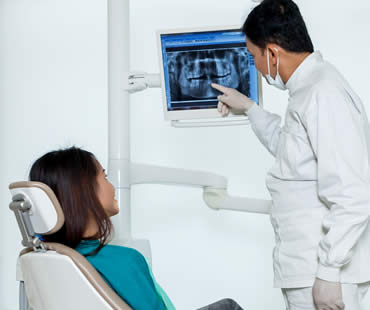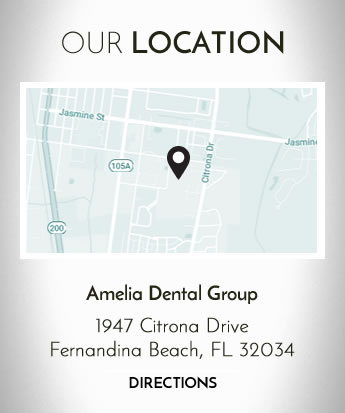
Wisdom teeth are really just your third molars, located in the very back of your tooth arch and are the last of your adult teeth to erupt. They most commonly erupt between the ages of 17 and 20. Most people have them, but for some people, these third molars simply do not develop. Some patients might have more than one set of wisdom teeth! Only an x-ray can reveal the complete story.
A high number of patients who possess wisdom teeth don’t know they have them because the teeth are impacted, or stuck underneath already erupted teeth, as opposed to erupting normally through the gums. This is when wisdom teeth become problematic.
The patient’s jaw may be too small to allow for the full eruption of the wisdom tooth, leading to it becoming stuck in the jaw, pushing at other teeth, causing pain and shifting of the teeth. The tooth might be able to erupt partially, triggering a flap of gum tissue to develop over the tooth, trapping bacteria and germs which can lead to serious infection.
Sometimes wisdom teeth come in at strange angles, facing sideways or backward, or they develop a serious infection and damage the surrounding teeth. They can also lead to the development of a cyst or cause damage to the jawbone.
If your dentist has told you that you need to have your wisdom teeth out, it’s a good idea to listen and to follow that advice. Removing problematic wisdom teeth can reduce crowding in the mouth, infection in the gums or tooth decay in the wisdom tooth or in the surrounding teeth.
The younger you are when you have your wisdom teeth removed, the easier it is to recover. Ask your dentist to learn more about wisdom teeth and about your particular needs as a patient.
We look forward to seeing you in our Fernandina Beach dental office

Your smile is a noticeable part of your appearance, and yellow dingy teeth can leave a negative impression on others. Most people have to work at having a bright sparkly smile, because teeth can discolor with age, diet, and lifestyle.
You may not realize that sipping a glass of red wine or coffee can be a detriment to your smile, as can sugary items that allow acids to attack your tooth enamel. Smoking is an even worse culprit. It not only leaves ugly spots on the surface of teeth, it also contributes to poor gum health.
If your teeth are already stained or if you’re having a hard time breaking the habits that discolor them, teeth whitening is a good way to improve the look of your smile. There are numerous methods to regain the natural glow of your teeth, ranging from over-the-counter techniques for home use to professional treatments in an office setting.
Whitening products available at your local drug or grocery store include things like toothpaste, chewing gum, mouthwash, gels, and whitening strips. These are readily available and usually inexpensive options. Most of these products are simple to use and can be done in the convenience of your home when you choose. However, over-the-counter products are not as strong as professional methods. This means that results are not dramatic and usually take a long period of time of consistent use. Also, the effects may not last as long as you hope before it’s time to consider whitening again.
Professional teeth whitening is often performed by general and cosmetic dentists in an office environment. Bleaching is a popular professional method. The biggest advantage of in-office treatment is the fast results, with a visibly brighter smile evident in about an hour. Results are often dramatic, lightening teeth by several shades. Professionals trained and experienced in these methods provide safe and effective treatment. Methods available professionally may cost a bit more than home options, but the dramatic results may be worth it.
We look forward to seeing you in our Fernandina Beach dental office

Obstructive sleep apnea is a condition created when a portion of the upper airway is blocked, causing breathing interruptions during sleep and low blood oxygen levels. As many as 20% of adults are affected by mild obstructive sleep apnea, while one in fifteen suffers from more severe apnea.
Symptoms of obstructive sleep apnea include snoring, extreme daytime drowsiness, restless sleep, high blood pressure, depression, problems with mental function, as well as a host of other mental and physical concerns. Left untreated, obstructive sleep apnea can lead to a long list of serious medical conditions, including hypertension, heart attack and stroke.
If you have been diagnosed with obstructive sleep apnea, your doctor may initially treat the condition with a CPAP device that you wear while sleeping. While a CPAP machine will reduce the obstruction to the airway, it is not a cure and will only be effective during use. Other non-surgical treatment recommendations may include the wearing of mouthguards to reposition the jaw, sleep position changes, or weight loss.
Tongue muscle advancement involves moving the bony attachment of the tongue muscles, and can be combined with palatal surgery to reduce excess tissues. This therapy may also include removing enlarged tonsils and nasal surgery. These treatments are most often used for milder cases of obstructive sleep apnea.
However, if these treatments do not work or for more severe cases of obstructive sleep apnea, oral surgery offers solutions to correct apnea. Maxillomandibular Advancement is a procedure that repositions the upper and lower jaw and chin to open the airway. This treatment is highly successful and offers the greatest chance of permanent correction in moderate to severe cases of obstructive sleep apnea.
For more information about how surgical therapies and treatments can be utilized to address your obstructive sleep apnea, consult with a qualified oral and maxillofacial surgeon.
We look forward to seeing you in our Fernandina Beach dental office

Family dentists are experts in treating patients no matter what their age or oral health. The goal of a family dentist is to care for every family member in one convenient location, so that each patient is comfortable and confident about visiting the dentist.
Young members of a family present unique issues when it comes to dentistry. Many children find dental offices scary and parents struggle to get necessary dental care for their kids. Family dentistry offers a calming and welcoming environment for children, often providing distractions like videos and games. Having the flexibility and expertise to work with kids is a great advantage of family dentistry, because learning to handle dental visits at a young age is a good start to a lifetime of dental success.
Dental professionals suggest that children begin seeing the dentist around their first birthday. Not only will the dentist check and treat the child’s oral health, the parents will be educated on proper dental care. They will learn how to help their children avoid cavities, gum disease, and other issues as more teeth erupt and the child’s mouth grows.
Family dentists treat pediatric patients, but they are also skilled in the oral health needs of adolescents. If kids grow up going to the dentist, they won’t be as nervous or frightened about instruments and procedures as they become more aware of treatment. Comfortable patients are much more likely to sit still during procedures. Also, family dentists are trained to recognize issues related to orthodontics as older children reach the age that orthodontic intervention might be necessary. Some family dentists practice orthodontics, and others refer patients to specialists.
Family dentists take care of mom and dad, and even grandma and grandpa, too. The whole family can enjoy seeing the same dental professionals in one office location, and establish a long-lasting relationship for everyone with their healthcare provider. Family dentists perform all sorts of dental procedures, so no one is left out in the specific needs that might affect certain age groups. Oral health should never be neglected, and family dentistry is a step in the right direction.
If you live in the Fernandina Beach area contact us today

What is a dental bridge?
- Dental bridges make a bridge between two anchor teeth and are meant to fill a space left by a missing tooth. Teeth can be missing due to trauma, decay or some type of natural loss. Dental crowns cap the anchor teeth, giving the bridge stability and giving the replacement tooth the strength to function as a natural tooth.
What is a dental crown?
- Dental crowns are a restorative treatment meant to protect a tooth that has gone bad due to cracking, acute decay, or has received root canal therapy. A crown is crafted to fit in your mouth and to function exactly as your natural tooth would. They work by covering the damaged tooth entirely and can change the shape or alignment of the prior natural tooth.
Isn’t a dental crown the same thing as a dental cap?
- A dental cap and a dental crown are two different terms for the same thing.
What are dental crowns made of?
- Dental crowns can be made of 100% ceramic (porcelain), porcelain-fused-to-metal, or gold or other metal alloy, including zirconia. Metal alloy dental crowns are typically stronger and more suited for back teeth.
Do dental crowns look natural?
- Crowns made from porcelain or ceramic can be very natural looking. Many materials have excellent translucency, and mimic your natural teeth very well.
Is a dental bridge an option for me?
- Are you missing a tooth? Are your adjacent teeth healthy and stable? If so, dental bridge treatment may be right for you.
Are there options available to me other than dental bridges to replace missing teeth?
- The best alternative option to replace a missing tooth is a dental implant. Dental implants can restore one or more teeth by being placed directly into the jawbone, fusing securely over time.
If you’re considering moving forward to replace your missing tooth or teeth, discuss options with your cosmetic dentist. Get the answers you need to determine if dental crowns or dental bridges can help you reach your smile goals.
Schedule your appointment at our Fernandina Beach dental office

Proper dental care and oral health should start early in life. Because children’s needs and dental procedures are different than those of adults, it’s important to find a family dental practice that can meet the needs of even the youngest members of your family. Your child’s first dental checkup should take place before the age of one, as soon as the first tooth has erupted. Some of the pediatric dental care options to look for in a family dental practice include:
- Child specific dental health exams and risk assessment
- Preventative oral care including cleanings, sealants, and fluoride treatments
- Care for dental trauma such as fractured, displaced or knocked-out teeth
- Treatment of dental cavities and defects
- Identification and treatment of gum inflammation and disease
- Early assessment, treatment, and recommendations for misaligned teeth or an improper bite
Along with the proper pediatric training, it’s essential that your family dentist is equipped to make your child feel comfortable and relaxed at dental visits. Many practices offer child-friendly amenities such as game rooms, videos, and prizes and rewards for completing a successful visit. Ask your family dentist if they allow parents to accompany children in the treatment room, as this will put both you and your child at ease.
To ensure a lifetime of excellent oral health, your child should visit the dentist every six months for dental cleanings and checkups. Children are not born with a fear of the dentist, and with the right family dental practice they should never have to develop that fear. Take the time to find a family dental practice that understands the special attention required to treat children so your entire family can enjoy visiting the dentist.
If you need a dentist in Fernandina Beach contact us today







